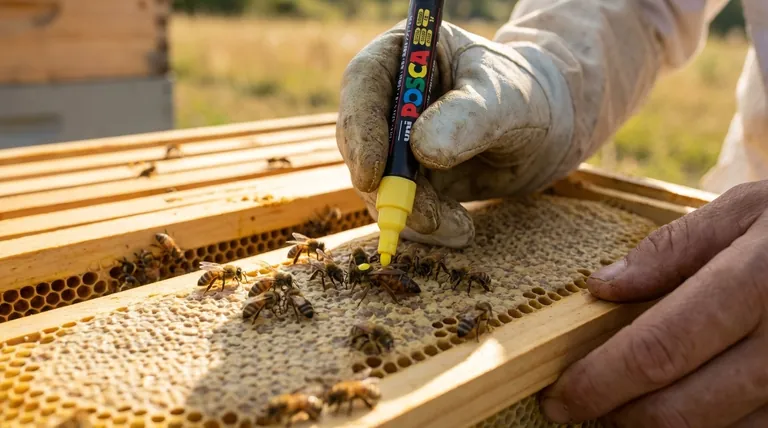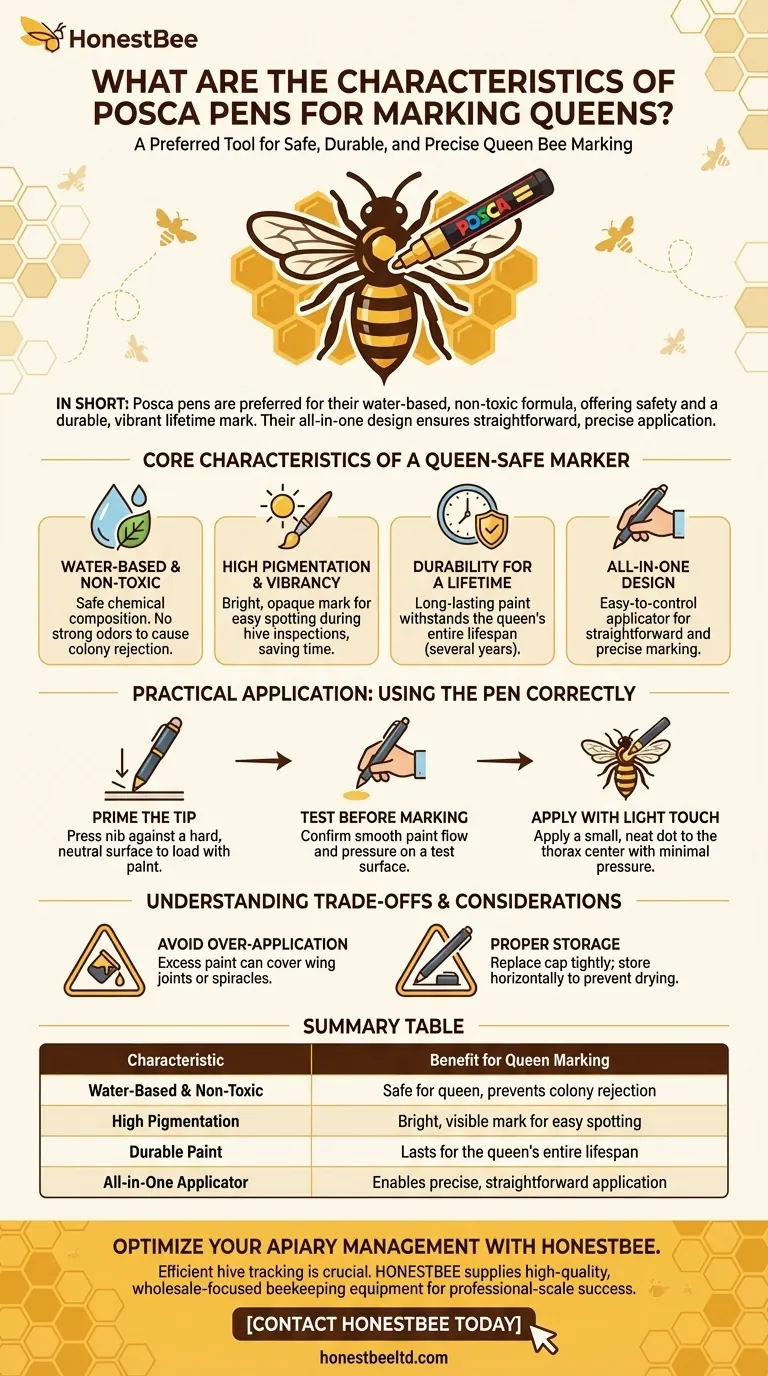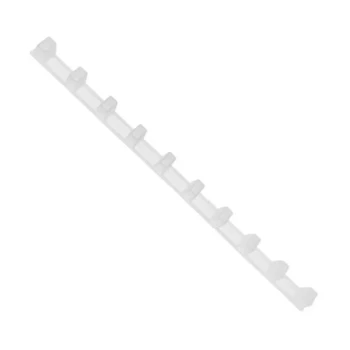In short, Posca pens are a preferred tool for marking queen bees because their water-based, non-toxic formula is safe for the queen, while the vibrant paint provides a durable mark that lasts her entire lifetime. Their all-in-one design makes the delicate process of marking straightforward and precise.
The central challenge in marking a queen bee is applying a long-lasting, highly visible mark without harming the bee or causing the colony to reject her. Posca pens solve this by offering a safe, water-based paint in an easy-to-control applicator, making them an ideal balance of safety and performance.

The Core Characteristics of a Queen-Safe Marker
The selection of a marking tool is not trivial; the health of your queen and the efficiency of your hive management depend on it. Posca pens have several key attributes that make them exceptionally well-suited for this task.
Water-Based and Non-Toxic Formula
The most critical feature is the chemical composition of the paint. Posca pens use a water-based, non-toxic acrylic paint.
This is essential for the queen's safety. Solvent-based markers can have strong odors that may cause the other bees to see the queen as a foreign invader, leading to her being rejected or killed.
High Pigmentation and Vibrancy
The paint is highly pigmented, creating a bright, opaque mark.
This ensures the queen is easy to spot during hive inspections, which saves time and reduces disruption to the colony. A quick glance is often all that is needed to confirm her presence.
Durability for a Lifetime Mark
The paint is formulated to be durable and long-lasting.
A single, correctly applied mark will typically last for the queen's entire lifespan, which can be several years. This avoids the need to recapture and re-mark her, minimizing stress on both the queen and the colony.
Practical Application: Using the Pen Correctly
Knowing the characteristics of the pen is only half the battle. Proper application technique is crucial to ensure the safety of the queen and the effectiveness of the mark.
The Importance of Priming the Tip
Before you approach the queen, you must prime the pen.
Press the nib several times against a hard, neutral surface, such as a hive lid or your thumbnail. This action loads the tip with the right amount of paint for application.
Applying with a Light, Precise Touch
The goal is to apply a small, neat dot of paint to the center of the queen's thorax.
Only a very light touch is needed. The pen is designed to release paint with minimal pressure, preventing any risk of crushing or injuring the delicate queen.
Testing Before Marking
Always test the paint flow just before marking the queen.
After priming, make a small dot on your test surface. This confirms that the paint is flowing smoothly and allows you to gauge how much pressure is needed for a perfect mark.
Understanding the Trade-offs and Considerations
While Posca pens are an excellent tool, responsible use requires awareness of potential pitfalls. Objectivity is key to successful beekeeping.
The Risk of Over-Application
Applying too much paint can be detrimental.
An excessive amount can run, potentially covering the queen's wing joints or spiracles (breathing pores). The goal is a small, controlled dot, not a large splotch.
Proper Storage is Key
These pens are an investment that can last for years, but only if stored properly.
Always replace the cap tightly after use to prevent the water-based paint from drying out in the nib. Storing them horizontally is often recommended to keep the pigment evenly distributed.
Other Tools Exist
Posca pens are a popular choice, but they are not the only option.
Beekeepers also use tools like numbered stickers or other specialized paint applicators. Each method has its own learning curve and requires a steady hand and careful handling of the queen.
Making the Right Choice for Your Goal
Your choice of marking tool should align directly with your priorities as a beekeeper.
- If your primary focus is safety and ease of use: Posca pens offer a reliable, low-toxicity solution in a simple, all-in-one format that is easy for most beekeepers to handle.
- If your primary focus is visibility and long-term tracking: The durable, highly-pigmented paint ensures the mark will last the queen's lifetime and be easily spotted during routine inspections.
By understanding these characteristics, you can confidently use a Posca pen to safely and effectively manage your queen.
Summary Table:
| Characteristic | Benefit for Queen Marking |
|---|---|
| Water-Based & Non-Toxic | Safe for the queen, prevents colony rejection |
| High Pigmentation | Creates a bright, visible mark for easy spotting |
| Durable Paint | Lasts for the queen's entire lifespan |
| All-in-One Applicator | Enables precise, straightforward application |
Optimize your apiary management with the right tools from HONESTBEE.
As a commercial apiary or beekeeping equipment distributor, efficient hive tracking is crucial for your operation's success. The precise, safe marking provided by tools like Posca pens is a key part of that process.
HONESTBEE supplies beekeepers and distributors with the high-quality, wholesale-focused beekeeping supplies and equipment needed for professional-scale success. Let us help you equip your operation for maximum efficiency and productivity.
Contact HONESTBEE today to discuss your wholesale supply needs and enhance your hive management.
Visual Guide

Related Products
- Queen Bee Marking Pen POSCA Queen Marking Pens for Beekeeping Bee Markers
- Queen Bee Marking Pen UNI Medium Point for Queen and Bee Marking
- Professional Engraved Round Hive Number Tags for Beekeeping
- Heavy Duty Stainless Steel Queen Bee Catcher Clip
- Plastic Queen Marking Tube Cage with Plunger for Beekeeping
People Also Ask
- What are the benefits of learning to mark your own queen bees? Boost Your Apiary's Efficiency and Confidence
- What is the purpose of marking queen bees with colors? Essential for Hive Management & Efficiency
- What are the benefits of marking a queen bee? Boost Efficiency & Hive Health
- What should you do immediately after marking a bee? Ensure a Clean, Durable Mark with This Key Step
- What type of markers are commonly used for marking Queen bees? Choose the Safe, Non-Toxic Standard



















